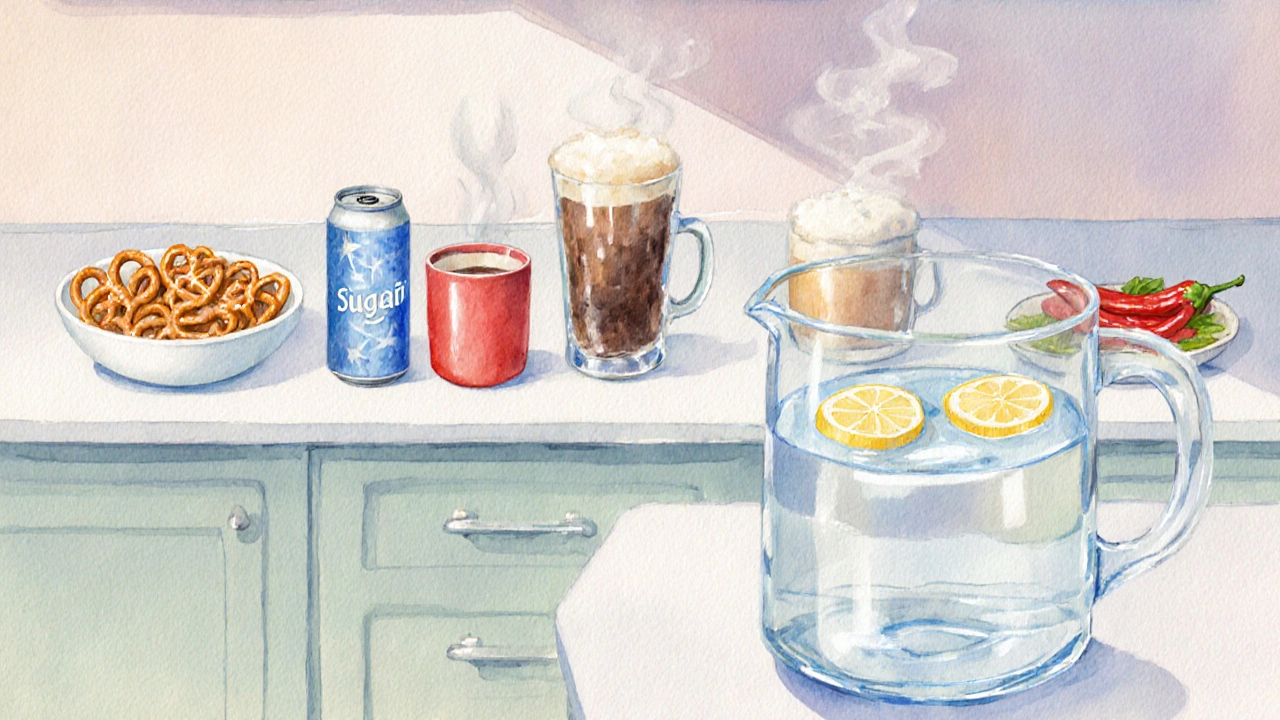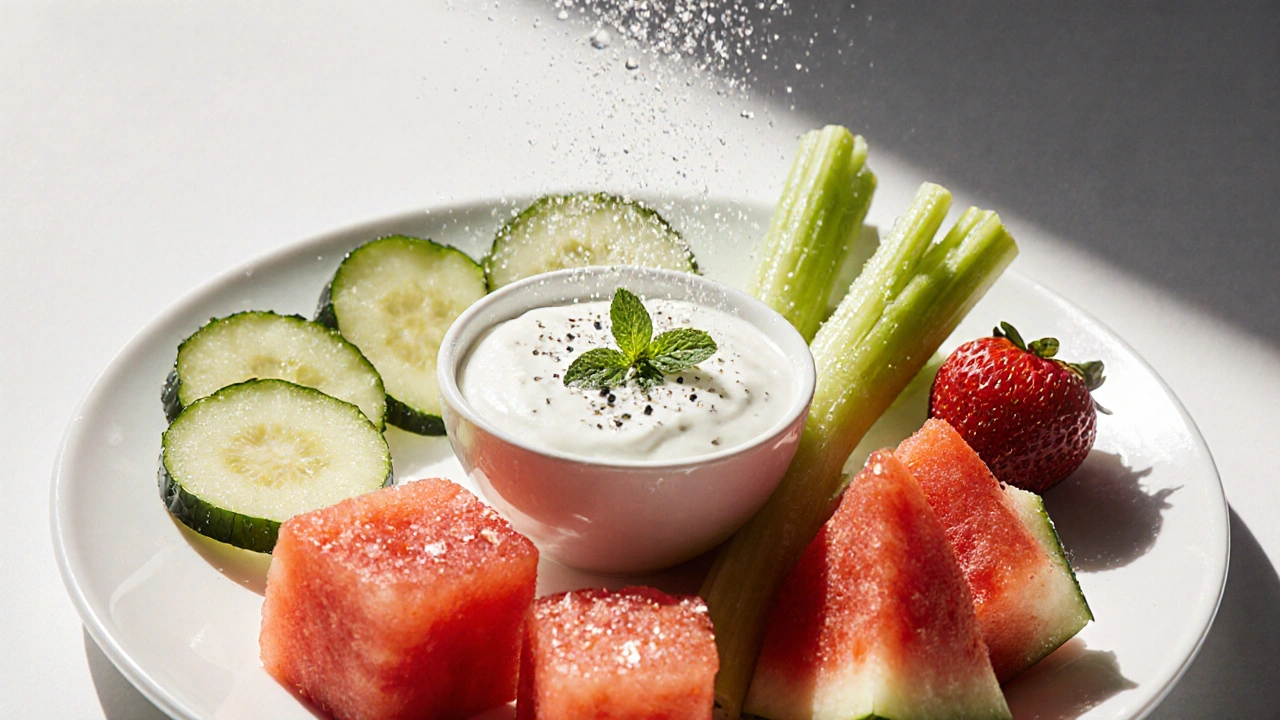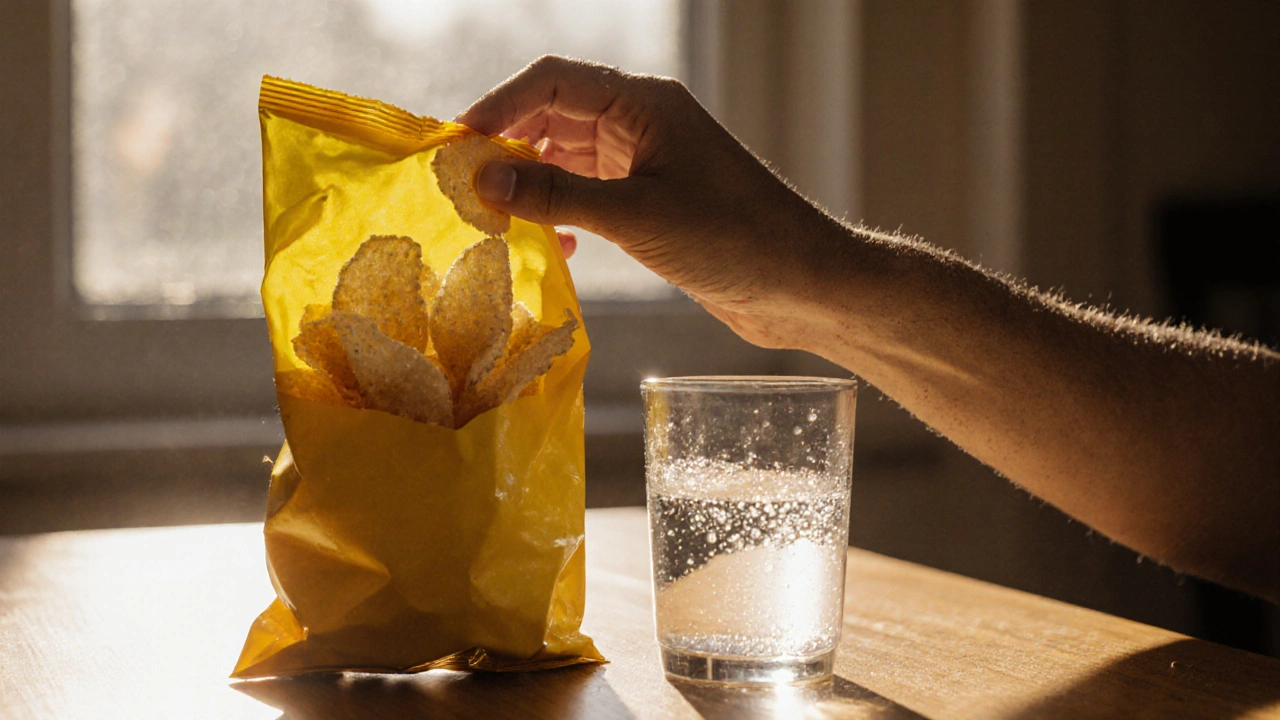Diet & Thirst Impact Calculator
Enter your food choices and click "Calculate Thirst Impact" to see how your diet influences thirst levels.
- Drink water before or with caffeinated/alcoholic beverages.
- Pair salty or sugary snacks with high-water-content foods like cucumber or watermelon.
- Choose herbs and spices over salt for flavoring.
- Opt for decaf in the afternoon to reduce diuretic effects.
Ever notice that after a salty snack or a strong cup of coffee you suddenly feel parched? What you eat can tug at the body’s water balance in ways most people don’t realize. This article breaks down the science behind diet‑induced thirst, points out the culprits, and gives you practical swaps so you stay comfortable without constantly reaching for a glass.
Key Takeaways
- High‑sodium, sugary, caffeinated, alcoholic, and very spicy foods all trigger mechanisms that raise thirst.
- Understanding how each food group affects blood‑volume and electrolyte balance helps you choose smarter snacks.
- Pairing dehydrating items with hydrating foods or extra water can blunt the thirst spike.
- Listening to true dehydration cues (dry mouth, dark urine) versus habit‑driven drinking is essential.
- Simple meal tweaks-like seasoning with herbs instead of salt-reduce daily thirst without sacrificing flavor.
What "thirst" Really Means
Thirst is the physiological drive to seek and ingest fluids to maintain proper hydration. When blood osmolarity rises or blood volume drops, the brain’s hypothalamus fires signals that make you feel the urge to drink. While this system protects you from severe dehydration, everyday dietary choices can constantly press those buttons.
Why Certain Foods Raise Thirst
Three main pathways link food to thirst:
- Osmotic load - consuming solutes like salt or sugar draws water out of cells, increasing plasma osmolarity.
- Diuretic effect - caffeine and alcohol boost urine output, cutting fluid volume.
- Thermal load - very spicy or hot foods raise core temperature, prompting sweat and fluid loss.
Each pathway is backed by research. For example, a 2023 nutrition study found that a single 250mg sodium snack boosted serum osmolarity by 3mOsm/kg, enough to trigger a noticeable thirst cue within 15minutes.
High‑Sodium Foods: The Classic Thirst Trigger
Sodium is an essential electrolyte that regulates fluid balance and nerve function. When you eat more sodium than your kidneys can excrete, extra water is pulled from your bloodstream into the extracellular space, raising serum osmolarity and prompting you to drink.
Common culprits include:
- Processed meats (bacon, ham, sausages)
- Bagged snacks (chips, pretzels, salted nuts)
- Fast‑food meals
- Condiments like soy sauce and ketchup
One tablespoon of soy sauce contains roughly 1,000mg of sodium-about 40% of the daily recommended limit. Swapping it for low‑sodium tamari or using herbs can cut that load dramatically.
Sugar and Blood Glucose Swings
When you eat sugary foods, blood glucose spikes cause the kidneys to excrete more water-a process called osmotic diuresis. The body tries to dilute the high sugar concentration, leading to a thirst response.
Typical offenders:
- Soft drinks and energy drinks
- Candies and chocolate bars
- Sweetened breakfast cereals
- Fruit juices with added sugar
Even natural sugars can be sneaky. A large banana packs about 14g of sugar, enough to nudge blood glucose upward if you’re not balancing it with protein or fiber.

Caffeine: The Mild Diuretic
Caffeine is a stimulant that increases urine production by blocking the hormone ADH (antidiuretic hormone). While moderate consumption (under 200mg per day) usually doesn’t cause severe dehydration, it can still raise thirst for sensitive individuals.
Sources include:
- Espresso and brewed coffee
- Black tea
- Energy drinks
- Chocolate
Switching half of your coffee intake to decaf or pairing it with a glass of water can keep the diuretic effect in check.
Alcohol: The Dehydrating Social Companion
Alcohol suppresses ADH even more aggressively than caffeine, leading to increased urine output. A standard 12‑oz beer can cause a loss of roughly 0.5L of fluid.
Beyond the fluid loss, alcoholic drinks often contain high levels of sodium or sugar, compounding the thirst effect. Hydrating with electrolyte‑rich water or alternating drinks with water helps mitigate the dryness.
Spicy and Hot Foods: Thermal Thirst
Capsaicin-the compound that makes chilies hot-raises body temperature and stimulates sweat glands. Sweating removes water, which the body replaces by prompting you to drink.
Examples:
- Hot sauces and chili powders
- Spicy curries and Sichuan dishes
- Buffalo wings and pepper‑infused snacks
If you love heat, keep a glass of cool water or a cucumber‑based salad on the side to offset the extra sweat loss.
Processed and Packaged Foods: Hidden Dehydrators
Many ready‑to‑eat meals contain a mix of sodium, sugar, and additives that together amplify thirst. Even foods that don’t taste salty can have high sodium levels.
Look for labels that list sodium under 140mg per serving or choose fresh, whole foods whenever possible.
Hydrating Alternatives: Foods That Help Quench Thirst
While the previous sections focused on what pushes thirst up, it’s helpful to know which foods actually *pull* water into your system.
High‑water‑content foods include:
- Cucumber (96% water)
- Watermelon (92% water)
- Celery (95% water)
- Strawberries (91% water)
- Yogurt with live cultures (contains electrolytes that aid absorption)
Adding these to meals can offset the dehydrating impact of a salty snack.

Comparison Table: Dehydrating vs. Hydrating Foods
| Category | Typical Examples | Main Thirst‑Trigger Mechanism | Water Content (%) |
|---|---|---|---|
| High‑Sodium | Potato chips, pretzels, soy sauce | Osmotic load | 5‑12 |
| Sugary | Sodas, candy, sweet cereals | Osmotic diuresis | 30‑70 |
| Caffeinated | Coffee, black tea, energy drinks | ADH inhibition | 40‑80 |
| Alcoholic | Beer, wine, cocktails | Strong ADH suppression | 35‑90 |
| Spicy | Hot sauce, chili dishes | Thermal sweat loss | 30‑80 |
| Hydrating | Cucumber, watermelon, strawberries, yogurt | Direct water intake + electrolytes | 91‑96 |
Practical Tips to Tame Thirst
- Read nutrition labels: aim for less than 140mg sodium per snack serving.
- Balance salty or sweet items with a side of raw veggies or fruit.
- Adopt a "water‑first" rule: drink a glass of water before any caffeinated or alcoholic beverage.
- Use herbs, citrus zest, or vinegar for flavor instead of salt.
- Choose decaf coffee or tea in the afternoon to reduce diuretic load.
When Thirst Is a Warning Sign
True dehydration shows up as:
- Dark yellow urine (amber) rather than pale straw color.
- Dry mouth, sticky feeling on the tongue.
- Headache or light‑headedness after standing.
- Reduced skin turgor (skin stays pinched longer).
If you notice these signs, it’s time to boost fluid intake and examine your diet for hidden dehydrators.
Final Thought: Mindful Eating for Balanced Hydration
Understanding that foods that cause increased thirst are often high in sodium, sugar, caffeine, alcohol, or spice gives you a clear roadmap. By swapping just one or two of those items each day, you can lower unnecessary thirst, save on those extra glasses of water, and keep your body humming along smoothly.
Frequently Asked Questions
Does drinking coffee really dehydrate me?
Moderate coffee (under 200mg caffeine) only has a mild diuretic effect. It won’t cause dehydration unless you replace water entirely with coffee. Pairing coffee with a glass of water keeps balance.
Can I eat salty foods if I drink a lot of water?
Yes, but the extra water you need may still be more than you want to drink. Reducing overall sodium is healthier for blood pressure and kidney load.
Why do I feel thirsty after a spicy meal?
Capsaicin raises body temperature and makes you sweat, which directly reduces fluid volume. The body signals thirst to replace what’s lost.
Are there any fruits that actually increase thirst?
Most fruits are highly hydrating, but very dry fruits like dried apricots or raisins are concentrated in sugar and can cause mild osmotic thirst if eaten in large amounts.
How much water should I drink after a night out?
A good rule is to replace each alcoholic drink with one 250ml glass of water, plus an extra 500ml before bed to compensate for the diuretic effect.


carol messum
October 9, 2025 AT 23:06Ever thought about how the salt on your chips actually teaches your kidneys to whisper for water? It’s a subtle reminder that what we eat can nudge our bodies in surprising ways. When sodium spikes, the body instinctively seeks balance, and that’s when thirst knocks. So, the next time you reach for a salty snack, consider a glass of water as a partner in crime.
Jennifer Ramos
October 12, 2025 AT 20:33Totally agree, and adding a splash of water while you snack can make the experience smoother 😄. It’s a simple habit that turns a salty bite into a balanced moment. Plus, staying hydrated helps keep that post‑snack crash at bay.
Grover Walters
October 15, 2025 AT 18:00From a physiological perspective, the osmoregulatory mechanisms in the hypothalamus detect plasma osmolarity shifts prompted by sodium intake. Consequently, antidiuretic hormone release is modulated to preserve fluid homeostasis. This cascade underscores why increased sodium correlates with heightened thirst sensations. The body’s feedback loop is both efficient and essential.
Amy Collins
October 18, 2025 AT 15:26Another useless calculator that tells you what common sense already knows.
mas aly
October 21, 2025 AT 12:53It’s true that we sometimes overlook how everyday choices stack up, especially with sugary drinks sneaking in beside our coffee. Pairing those drinks with water‑rich foods like cucumber can alleviate that relentless thirst. Small swaps add up without feeling like a diet overhaul.
Abhishek Vora
October 24, 2025 AT 10:20When you examine the diet–thirst relationship, sodium emerges as a primary driver because it raises plasma osmolality, prompting the body to conserve water and signal thirst. High‑sodium snacks such as processed meats or soy sauce not only increase this osmotic load but also stimulate the renin‑angiotensin‑aldosterone system, further encouraging fluid retention and a subsequent craving for water to dilute the concentration. Sugary beverages add another layer by introducing glucose, which the kidneys filter and require water to excrete, thereby amplifying the need for hydration. Caffeine, despite its reputation as a diuretic, actually causes a modest increase in urine output only when consumed in large quantities, yet it also stimulates adenosine receptors that can raise heart rate and indirectly boost thirst. Alcohol, being a potent diuretic, suppresses antidiuretic hormone release, leading to increased urine production and a rapid depletion of body water stores, which the brain interprets as dehydration. Spicy foods trigger the release of capsaicin, activating TRPV1 receptors that not only produce a burning sensation but also stimulate salivation and a mild increase in metabolic heat, both of which can heighten the perception of thirst. The cumulative effect of these food groups means that a person who regularly indulges in salty chips, sugary sodas, multiple cups of coffee, nightly glasses of wine, and hot curry may find themselves reaching for water far more often than someone with a milder diet. Hydration strategies, therefore, should not rely solely on drinking water but also on balancing electrolyte intake, perhaps by incorporating potassium‑rich foods like bananas or leafy greens that counteract sodium’s effects. Moreover, consuming water‑dense fruits such as watermelon or cucumber alongside high‑sodium meals can provide immediate fluid and a sense of satiety, reducing the urgency to gulp down larger volumes later. It is also advisable to sip water before, during, and after meals that contain high levels of salt or sugar to pre‑empt the osmotic surge. For caffeine and alcohol consumers, alternating each alcoholic or caffeinated drink with a glass of plain water can mitigate diuretic losses and preserve overall fluid balance. In addition, choosing decaffeinated coffee in the afternoon can lower nighttime diuresis, improving sleep quality and subsequent hydration status. Finally, monitoring personal thirst cues and adjusting intake based on activity level, climate, and individual metabolism remains essential, as the body’s signals are the most reliable guide to adequate hydration.
maurice screti
October 27, 2025 AT 07:46Indeed, the interplay between dietary constituents and thirst is an intricate tapestry woven from the threads of osmotic pressure, hormonal cascades, and neurophysiological feedback loops, a veritable symphony wherein each nutrient assumes its role as a virtuoso or a discordant note. One might posit that the casual consumer, unaware of these subtleties, merely observes an inexplicable craving for liquid after indulging in a bag of pretzels, yet the underlying mechanisms are far more sophisticated than mere anecdote. By appreciating the nuanced contributions of each macro‑ and micronutrient, particularly the sodium‑induced augmentation of extracellular fluid osmolarity, we elevate our comprehension from the realm of the pedestrian to that of the erudite. Thus, when one engages with the aforementioned calculator, it serves not merely as a novelty but as an educational conduit, illuminating the physiological ramifications of our culinary predilections. In the broader context of nutritional science, such tools underscore the imperative of integrating quantitative assessments with qualitative, experiential knowledge, thereby fostering a holistic approach to health optimization.
Abigail Adams
October 30, 2025 AT 05:13The data clearly illustrate that a diet rich in sodium and sugar precipitates a measurable increase in daily water requirements, a fact that cannot be ignored by anyone seeking optimal health. By consciously moderating these components and pairing them with hydrating foods, individuals can effectively manage their thirst without resorting to excessive water consumption. This balanced approach not only supports renal function but also contributes to better overall well‑being.
Belle Koschier
November 2, 2025 AT 02:40Finding that middle ground by swapping out a salty snack for a handful of grapes can make a noticeable difference without feeling deprived. Small, sustainable changes often lead to the biggest long‑term benefits, and they’re easy to incorporate into daily routines.
Allison Song
November 5, 2025 AT 00:06Considering the body's feedback mechanisms, it becomes evident that our dietary choices act as signals prompting adjustments in fluid intake. When we learn to interpret these signals, we can fine‑tune our hydration habits to better match our physiological needs.
Joseph Bowman
November 7, 2025 AT 21:33It’s interesting how the mainstream diet advice often downplays the hidden thirst‑inducing effects of everyday foods, almost as if there’s a hidden agenda to keep us reaching for sugary drinks. By staying aware and using tools like this calculator, we can reclaim control over our own hydration patterns and avoid being nudged into unnecessary consumption.
Singh Bhinder
November 10, 2025 AT 19:00Observing the patterns in personal water intake after meals high in spice or caffeine reveals a consistent trend of heightened thirst, suggesting a direct physiological link rather than mere coincidence. This reinforces the importance of monitoring food‑related cues when planning hydration strategies.
Kelly Diglio
November 13, 2025 AT 16:26Understanding how each component of our diet influences thirst can empower individuals to make informed decisions that align with their health goals. By integrating simple practices-such as drinking a glass of water alongside salty meals or choosing fruit‑rich snacks-we can improve hydration without drastic lifestyle changes. This balanced perspective supports both physical well‑being and a sustainable approach to nutrition.
Carmelita Smith
November 16, 2025 AT 13:53Just add water when you snack, simple as that.